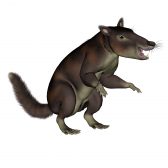Feeding
Giving food or nourishment.
You will also like...

Mammalian Ancestors
Mammals are a diverse group of organisms, where most of them develop their offspring within the uterus of the mother. Over time, mammals have diversified into the placentals and the marsupials. Get a better understanding of how the mammals became dominant based on natural selection and geological events as elucidated in this tutorial...

Freshwater Community Energy Relationships – Producers & Consumers
This tutorial looks at the relationship between organisms. It also explores how energy is passed on in the food chain and ecological pyramids...

Growth and Plant Hormones
Plants, like animals, produce hormones to regulate plant activities, including growth. They need these hormones to respond well to their environment and to sustain growth, development, and dispersal. Plant biologists recognize five major groups of plant hormones: auxins, gibberellins, ethylene, cytokinins, and abscisic acid. Find out in this guide the importance of each hormone in the life of a plant...

Origins of Life on Earth
Earth was created around 4.5 billion years ago and life began not long after. Primitive life likely possessed the element carbon within them. It is presumed that one of the family of compounds that first came up was the amino acids, the building blocks of protein. Over time, these life forms become more and more complex. Find out more about how life likely began on Earth...

Sigmund Freud and Carl Gustav Jung
In this tutorial, the works of Carl Gustav Jung and Sigmund Freud are described. Both of them actively pursued the way humans dream. Get acquainted with these two prominent neurologists and their works through this tutorial...

Physical Development in Humans
This tutorial elaborates on the physical development of humans, particularly from puberty to adulthood. Read this tutorial to know the specific physical changes that female and male bodies undergo as they turn into adults...
